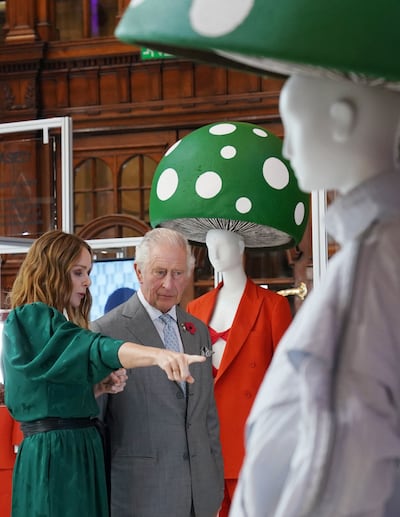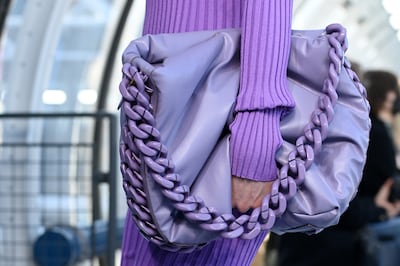“Fashion is one of the most harmful industries on the planet,” says designer Stella McCartney in no uncertain terms.
Famed for eschewing fur, leather and feathers since founding her eponymous company in 2001, McCartney was, for years, viewed as the industry outlier. She says she was regarded as a “weirdo”, and repeatedly told that her cruelty-free label would fail for not embracing animal-derived materials.
Two decades on, she heads a company that covers women's, men's and children's wear, as well as shoes, bags and accessories, with a revenue of £32.49m, as of 2021. In addition, McCartney has collaborated with adidas on a line of sportswear since 2005.

In current climes, as the detrimental impact of the apparel industry on the planet is becoming clearer, brands that were once dismissive of her ethical stance are now racing to align with it.
The fatal side of fashion
From the continuing exploitation of workers – there has been little meaningful change since the Rana Plaza disaster in 2013 that killed thousands – to the 100 billion new garments produced worldwide every year that are, according to Earth.org, enough to clothe every man, woman and child 10 times over, the figures emerging from the fashion industry make for grim reading.
Take for example the 900 million items of second-hand clothing that were exported to Kenya alone in 2021, with hundreds of millions more shipped to sub-Saharan Africa, decimating the business of local clothing manufacturers and clogging landfill.
In 2020, the BBC declared that one polyester shirt produces the equivalent of 5.5kg of carbon dioxide, while Climate Trade, Ellen MacArthur Foundation and United Nations Environment Programme declare the fashion industry responsible for 10 per cent of all global carbon emissions, more than the aviation and maritime shipping industries combined.
Despite these alarming figures, McCartney is the only major designer attending Cop28, where she will host a fireside chat, titled Pioneering Fashion Sustainability, at 2.30pm today.
“I think the lack of representation from the industry and the lack of fashion topics on the official Cop agenda shows we still have a long way to go before governments and brands understand the true impact and contribution this industry is having on the planet,” she says.
Having previously attended Cop26 in Glasgow, where she called out the industry for “getting away with murder” due to poor self-regulation and accountability, McCartney is heading to Dubai with a bigger, more high-profile agenda.
“I am proudly attending Cop28 to represent the fashion industry. I want to bring to the forefront the significant role the fashion sector has to play in environmental sustainability and the urgency of transitioning towards more eco-friendly practices. I will take the opportunity to meet with those stakeholders who have the ability to enforce real change. I want to be in the room in order to drive this conversation forward.”
The conversation is complex and multilayered, however. The lower echelons of the industry, for example, are overtly reliant on cheap, durable fabrics such as polyester and nylon, which are oil-derived and non-biodegradable. Oil-based materials also degrade with use, releasing microscopic particles that can infiltrate water and food supplies.
Stella McCartney talks about sustainable fashion at Cop28

Acrylic, another material used frequently across the industry, is non-biodegradable and non-recyclable, meaning there is no way to remove it aside from burying in landfill or burning. A key ingredient in acrylic, acrylonitrile is a known carcinogen, according to the Centres for Disease Control and Prevention.
Even materials regarded as more environmentally friendly – including viscose, rayon and cotton – are problematic. Rayon, a by-product of the logging industry, is made from cellulose pulp extracted from trees, but it requires aggressive chemicals such as sodium hydroxide for manufacture.
Cotton, organic or otherwise, is highly water-intensive, requiring 10,000 litres to produce just a kilo of fabric – about one T-shirt’s worth. Worldwide, the cotton industry consumes more than 250 billion tonnes of water annually, a figure that Common Objective, a support network for fashion companies looking to increase environmental credentials, equates to four per cent of all freshwater extracted. This is set to double by 2030 if nothing is done to rectify it.
Such figures, while difficult to comprehend, must be used to support change, McCartney says.
“Through the installation we will be presenting at Cop28 – which highlights the work of 15 incredible material innovations – I want to highlight our commitment to environmental efforts and sustainable innovation, not only to government and business leaders, but also to the consumer base and global community. This can show there is great hope for the future and that you can conduct business that is kind to Mother Nature.
“My attendance reflects a responsibility and a readiness to engage in creative solutions, dialogues and actions aimed at mitigating climate change, and I can’t wait to get started!”
Vegan fashion
McCartney's own collaboration with adidas has seen new materials trialed with the aim of phasing out all virgin polyester by 2024, including the Parley UltraBoost X trainer made from reclaimed ocean plastic alongside Parley for the Oceans.

A new vegan leather called Vegea has also been made in conjunction with Veuve Clicquot – made from grape stems, it is 80 per cent vegetal, renewable and recyclable. It debuts as bags in McCartney’s spring / summer 2024 collection.
“In the last few years, we have seen the development of incredible technologies, capable of breaking down used garments into their basic fibres, which can then be reused to create high-quality fabrics,” she says. For example, McCartney is already investing in a textile, Protein Evolution, and creating materials from captured greenhouse gases that, she says, “is so exciting to me”.
“These kinds of circular approaches cannot only dramatically reduce waste and the demand for virgin materials, but also ultimately lead to a new form of sustainable business that is integral to our survival.”
Raised a vegetarian by her parents Paul and Linda McCartney, the designer has never used leather. However, she admits to not making the connection between leather and the meat and dairy industries until 2005, when she read the UN’s Livestock’s Long Shadow report, which outlined the impact that animal agriculture has on the environment. According to Faunalytics, more than 293 million cattle were slaughtered for their meat and skin in 2020 alone.
While she has consistently rejected animal products for her brand, McCartney says it was never a conscious business choice. “It’s not something I thought too much about when I was starting,” she explains. “I was just conducting my business in a way that aligned with my values, so obviously I was never going to kill any innocent animals by using leather or fur in my collections.
“Fast-forward 22 years and, to this day, there aren’t many other creative directors flying this flag. So in some way, I feel responsible to show others how it can be done. I hope my voice and actions inspire other fashion brands, as well as other industries altogether, to follow suit, promoting a broader culture of sustainability.”
Everyone has a role to play
For this to work, McCartney explains that we are all involved. “The public, too, has an integral role to play by demanding transparency and accountability from brands and governments. Meanwhile, governments need to create incentives for businesses to work in a more sustainable way.”
To bring this about, McCartney says that we need to collectively call out the stranglehold that some industries have on policy-making. She cites the additional 30 per cent tax levied on the vegan leather alternatives her company imports into the US, as an example.
“This is a direct result of the leather industry’s lobbying and is counterproductive to our shared goals of fighting the climate crisis and protecting our planet for future generations.”
While progress may be slow, McCartney is adamant it can be made. “If I didn’t have hope, I wouldn’t be working so hard in this space. For me, sustainability is so much more than a trend or marketing ploy. It is something I feel deeply in my heart that we must do to protect our fellow creatures, our planet and our children’s future.
“At the end of the day, this is not only good for our collective well-being, but is also good business. It presents a huge opportunity for any company willing to be brave and bold enough.”

Change comes through transparency, McCartney believes, and being accountable to customers. “All companies should measure and disclose their impacts. What you cannot see, you cannot know. Transparency and disclosure are the baseline to being able to identify impacts and hot spots – and use this knowledge to continuously improve.”
Such analysis has had a direct impact on her own company, she says. In 2014, the data revealed that just one material dominated the company's footprint. “Even though cashmere represented just 0.1 per cent of all the materials we used, it accounted for 42 per cent of our total environmental impact at the raw material stage.”
This prompted the company to switch from using virgin cashmere to Re-Verso in 2016. Made from post-factory cashmere waste in Italy, it helps address the damage caused by the ballooning demand for the fabric.
The number of goats being farmed has risen from 2.3 million to 30 million in under 30 years, which has led to widespread deforestation across the fragile ecosystem of the Mongolian Gobi desert. “This insight led to our decision to stop using virgin cashmere and transition to regenerated cashmere yarn. By 2016, cashmere represented just 11 per cent of our total impact, despite using larger quantities of the material,” says McCartney.
“Today we are continuing to push towards solutions that will protect our better tomorrow. I think everyone that’s a scale player has to play a role in change. I hope that businesses and governments start to prioritise a responsible way of working to make changes that go above and beyond a financial decision.
“I do believe if we can continue to progress, and if we truly want it, then we can replace bad business with clean business and in turn, a better future for all.”





